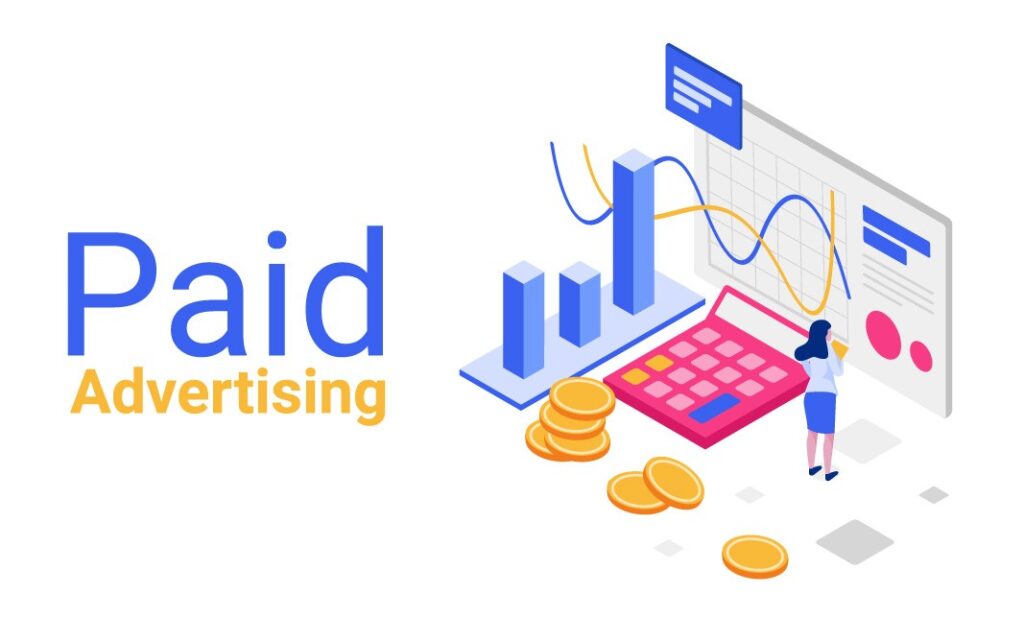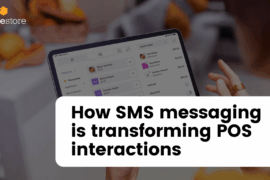As businesses continue to seek ways to reach their target audiences, paid advertising has emerged as a favorite marketing tactic.
Almost half of the total digital ad spend is spent on various types of paid advertising.
If you look at how paid ads fare, that number won’t be surprising. Paid ads yield excellent results. It enhances brand presence and awareness, drives targeted traffic, generates leads, and boosts sales. In fact, pay-per-click advertising, a common model used in paid advertising, generates an average conversion rate between 2% and 5%, depending on the industry.
The thing is, integrating paid ads into your marketing strategy isn’t as easy as it sounds. In this article, you’ll learn how to seamlessly incorporate them into your marketing efforts to reap their excellent benefits.
What is paid advertising?
Paid advertising is a marketing model that sees an advertiser paying for ad space to promote its brand, products, and services. Although paid ads technically also cover ads placed on traditional media such as television and newspapers, the term has become more associated with Internet-based ads.
Types of paid ads
Digital marketers can use different types of paid ads. These are categorized based on their formats and the platforms on which they appear. Here are some popular types:
Search engine advertising
These are ads that appear in search engine results pages on Google, Bing, or other search engines when users make a specific search query.
The good thing about search engine advertising is that your ads will likely be seen by your potential customers. After all, almost half of all Internet users utilize search engines on a typical day.
You can use advertising platforms such as Google Ads or Microsoft Advertising. For SaaS businesses, leveraging Google Ads for SaaS can be an especially effective way to generate qualified leads quickly. Search engine ads typically utilize a pay-per-click model. You bid on the keywords you’d like and pay for the clicks you get.
Display advertising
Display ads appear on websites and mobile apps, among others. They can come in different forms, from static images to video content and graphics.
Banner ads and native ads are examples of display advertising. Banner ads are advertisements that are placed in high-traffic places on a website. Native ads are ads on a website, too, but they differ from other types of ads in that they match the site’s design and feel.
In general, display ads are great for retargeting potential customers. Assume someone gains access to your website through Yahoo Search and checks out your sneaker products. Once they leave, your sneaker ads can appear when they log into their Yahoo email, for example.
Display ads can also be contextual. For instance, an ad promoting new pet food can appear in a blog post about dogs.
Besides Yahoo Advertising, popular display advertising networks include Taboola, Meta’s Audience Network, and Google Display Network.
Social media advertising
These ads are placed on social platforms such as TikTok, LinkedIn, and Facebook. Social media ads are great for their targeting features. Advertisers can use data such as age, interests, and location gathered by these social media platforms to reach specific audiences.
For instance, an Instagram ad promoting a software product like GoDaddy can appear in the feed of a person who has been interacting with digital marketing content.
You don’t have to use one paid ad format at a time. Some platforms allow you to access different types of paid advertisements for a single campaign. For instance, with a Google Ads Pmax campaign, you can leverage advertisements across all Google channels like YouTube, Display, and Search.
Empowered by your specific advertising objective, a Performance Max campaign uses Google AI across important aspects such as bidding, budget optimization, audiences, and creatives to help you convert customers. This is one of the various ways the use of AI in marketing is enhancing workflows. Marketers can use these AI tools for better targeting and data-informed decision-making.
How to create a paid ad marketing strategy
Now let’s go to the meat of this article. How exactly can you integrate paid ads into your marketing strategy? Follow these steps:
1. Set goals and choose audience
Before anything else, you need to set your advertising goals. Your advertising goals will determine the paid ad formats you’ll use and your key metrics.
For instance, if you aim to increase brand awareness, then you might opt for search engine ads since, as we’ve seen a while ago, most consumers (about 88% of the global population) use search engines. To determine whether your brand awareness campaign is successful or not, you’ll have to check metrics such as impressions and clicks.
But if your goal is to sell, then you might opt for display ads instead. This way, your ad will be shown on a website frequented by people likely to buy your product. You’ll look at sales as your metric instead, rather than impressions and clicks.
When setting your goals, make sure you also identify your target audience. Conduct market research to determine your ideal customer’s pain points. Send them surveys to determine their interests and demographic data. AI survey analysis can help you detect patterns, segment audiences, and predict customer preferences with greater precision. Then, create a buyer persona, which is a fictional representation of your target audience. Your buyer persona will serve as your guide when you start crafting your ad content later.
Whatever advertising goals you set, make sure they’re Specific, Measurable, Achievable, Relevant, and Time-Bound. So, instead of the generic advertising goal of “to increase brand awareness,” your SMART goal can be “to increase website visitors aged 20 to 35 who are interested in hair products by 20% through paid ads by November.”
SMART advertising goals will help you craft effective strategies that will enable you to reach those goals in the first place. It’s also easier to track these goals.
2. Create compelling ad content
Once you know your goals, you’ll need to create your ad content (your paid ad and landing page copy).
A paid ad has several elements, including its copy, compelling visuals, and call to action.
You can start with paid ad creation by crafting your ad’s message based on your advertising goal. What exactly do you want your ad to say? For instance, if your advertising goal is to increase online sales, then your paid ad message must clearly state the benefit of your product.
Here is an example of a paid ad copy.
You’ll need to experiment with different paid ad copies to see what produces the best results.
But remember that the key is to be concise in your paid ad messaging. Highlight the benefit your target audience will gain when they click your CTA. Your visuals also need to be high-quality, of course.
Your target audience will land on your landing page once they click your paid ad CTA. When crafting this page, you must ensure it reinforces what your paid ad says. You can use AI tools like Axios HQ’s rewording tool or an AI humanizer to humanize your landing page message and ensure it reflects your paid ad’s message.
But it’s not just about consistency in the copy.
Your overall landing page look and feel must also be similar to your ads.
Remember, the goal is a cohesive experience. You wouldn’t want your target audience to think they were directed to the wrong place when they clicked your paid ad CTA. They’ll only end up leaving without taking your desired action.
3. Set a budget and choose platforms
You might already have a fixed budget for your paid advertising. To give you an idea, the general recommendation is to allocate 5 to 10% of your marketing budget to paid ads.
But if that’s not the case, you might want to set your own paid ads budget based on your desired return on investment.
Assume you want to generate 10 sales from your paid ads campaign and that, historically, you generate $500 in profit from a single sale.
Since, based on the data available, for 10 sales, you’d generate $5000 in profit, your paid advertising budget should ideally be lower than $5000. The lower, the better, since the higher your ROI will be.
Once you know your paid ad campaign budget, all you need to do is choose your ad platform. Just go back to your advertising goals. Is your goal to increase brand awareness? Then, search engine ads might be your best bet. All you’d need to do is choose among the search engine options available (Google, Bing, others).
Ultimately, your choice should depend on the platforms your target audience frequents. You can go back to your buyer persona to determine this.
Once you’ve chosen your ideal platform, just specify your paid ad budget. Most platforms let you set a maximum amount across all your paid ad campaigns in your account and/or an average amount to spend on an ad set or campaign each day.
4. Run, monitor, and optimize your campaign
You’ll never really know if your paid advertising strategy is effective until you run your campaign. Don’t worry. You don’t need to check in on your campaign every single day.
The best thing to do is to wait for at least a week. This way, you can get an idea of emerging trends and more comprehensive, accurate data.
Most ad platforms have tools you can use for your campaign analysis. For instance, Meta’s Ads Manager can give you detailed reports about your Facebook and Instagram ads performance. It tells you how many clicks your ads generated and even the demographics of those who engage with it.
Based on the data you see, if your ads are successful according to the metrics you set initially, then just carry on with your campaign. But if you find that they’re not reaching those metrics and, therefore, your advertising goals, then make the necessary adjustments.
Let’s say Meta tells you your Facebook ad gets many clicks, but you don’t see these translating into sales. Then you might have to make adjustments to your corresponding landing page to optimize conversion rates. You can A/B test different versions of your page to see which yields the best results and use that for your campaign instead. Then you’d have to monitor the results and optimize again if needed.
In closing
Incorporating paid ads into your marketing strategy improves your brand’s reach and, ultimately, impact. But you need to do this the right way.
This article taught you how to integrate paid advertising into your marketing plan properly.
First, set goals and choose your audience. Then, create compelling ad content, which includes your paid ad and custom landing page. Set your budget and choose your platform according to your set advertising goals. Finally, run, monitor, and optimize your paid ad campaigns.
Follow these tips to supercharge your digital marketing and advertising efforts to achieve business growth.
Author Bio
David Pagotto is the Founder and Managing Director of SIXGUN, a digital marketing agency based in Melbourne. He has been involved in digital marketing for over 10 years, helping organizations get more customers, more reach, and more impact.




